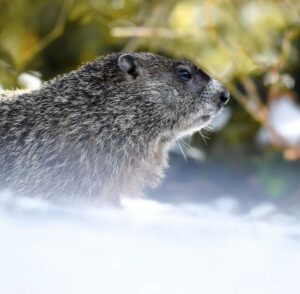Where do animals go in the winter?
December 14, 2022
Posted by Lake Erie Nature and Science Center

Many types of birds (including retiree snowbirds!) migrate south for the winter. While most of us would prefer to spend the cold months in a tropical climate, many Ohio residents, human and animal, ride out the snowy season at home.
Non-migratory animals have developed numerous adaptations to survive through chilly weather. Some, like deer and eastern cottontails, continue their business as usual, grazing for food but growing thicker coats and finding sheltered places to stay warm. Many of the animals you see during the summer, such as snakes, chipmunks and woodchuck, are conspicuously absent in winter. Where do they go, if they are not heading for warmer climates?
Snakes
Since snakes are cold-blooded, their body temperature depends on the temperature of their environment—which means bad news for snakes when the snow starts falling. To stay warm, snakes hunker down in dens called hibernacula. Snakes create hibernacula in holes in the ground, burrows of other animals or even a warm niche in your garage or basement. Once they find a cozy space, snakes enter a state called brumation. Their body temperature lowers and their metabolism slows down so they do not need to eat. While they are awake, snakes become very slow and sluggish. They may emerge from their hibernacula on warmer days to sunbathe and warm up, but for the most part will spend the winter underground.
Chipmunks
You may have experienced chipmunks raiding your bird feeder all summer, but they were not doing it out of spite—they were stocking up food for the long winter months. Chipmunks need these food stores because they do not hibernate fully. They enter something called torpor, where they essentially sleep very deeply for several days at a time. During these periods, their heart rate slows from around 350 beats to four beats per minute, and their body temperature can drop to 40 degrees. When they wake, it is critical for them to have sufficient food stores, because chipmunks rely on meals rather than fat reserves to survive the winter.
Woodchuck
While snakes and chipmunks slow down, woodchucks hibernate completely. Much like chipmunks, their heart rate slows, their body temperature drops and they are incredibly difficult to wake. Unlike chipmunks, once a woodchuck is asleep in its underground burrow, they stay that way all winter. Woodchucks do not wake up to eat or drink, and survive on fat stores they built up in the warm months. Our local woodchucks are currently hibernating and will not reemerge until February. Over that time, their body weight will drop by about 30 percent, so expect to see thin woodchucks in the spring!
While animals have adapted well to our cold weather, they occasionally do need assistance. If you find an animal that you believe to be injured or ill, please contact Lake Erie Nature & Science Center at 440-871-2900 or wildlife@lensc.org before intervening.

